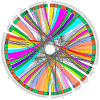Molecular Characterization of Indigenous Rhizobia from Kenyan Soils Nodulating with Common Beans
- PMID: 37298462
- PMCID: PMC10253646
- DOI: 10.3390/ijms24119509
Molecular Characterization of Indigenous Rhizobia from Kenyan Soils Nodulating with Common Beans
Abstract
Kenya is the seventh most prominent producer of common beans globally and the second leading producer in East Africa. However, the annual national productivity is low due to insufficient quantities of vital nutrients and nitrogen in the soils. Rhizobia are symbiotic bacteria that fix nitrogen through their interaction with leguminous plants. Nevertheless, inoculating beans with commercial rhizobia inoculants results in sparse nodulation and low nitrogen supply to the host plants because these strains are poorly adapted to the local soils. Several studies describe native rhizobia with much better symbiotic capabilities than commercial strains, but only a few have conducted field studies. This study aimed to test the competence of new rhizobia strains that we isolated from Western Kenya soils and for which the symbiotic efficiency was successfully determined in greenhouse experiments. Furthermore, we present and analyze the whole-genome sequence for a promising candidate for agricultural application, which has high nitrogen fixation features and promotes common bean yields in field studies. Plants inoculated with the rhizobial isolate S3 or with a consortium of local isolates (COMB), including S3, produced a significantly higher number of seeds and seed dry weight when compared to uninoculated control plants at two study sites. The performance of plants inoculated with commercial isolate CIAT899 was not significantly different from uninoculated plants (p > 0.05), indicating tight competition from native rhizobia for nodule occupancy. Pangenome analysis and the overall genome-related indices showed that S3 is a member of R. phaseoli. However, synteny analysis revealed significant differences in the gene order, orientation, and copy numbers between S3 and the reference R. phaseoli. Isolate S3 is phylogenomically similar to R. phaseoli. However, it has undergone significant genome rearrangements (global mutagenesis) to adapt to harsh conditions in Kenyan soils. Its high nitrogen fixation ability shows optimal adaptation to Kenyan soils, and the strain can potentially replace nitrogenous fertilizer application. We recommend that extensive fieldwork in other parts of the country over a period of five years be performed on S3 to check on how the yield changes with varying whether conditions.
Keywords: comparative genomics; pangenome; rhizobia; symbiotic potential; synteny.
Conflict of interest statement
The authors declare no conflict of interest.
Figures






Similar articles
-
Isolation and Characterization of High-Efficiency Rhizobia From Western Kenya Nodulating With Common Bean.Front Microbiol. 2021 Sep 10;12:697567. doi: 10.3389/fmicb.2021.697567. eCollection 2021. Front Microbiol. 2021. PMID: 34566909 Free PMC article.
-
Genetic diversity and symbiotic effectiveness of Phaseolus vulgaris-nodulating rhizobia in Kenya.Syst Appl Microbiol. 2018 Jul;41(4):291-299. doi: 10.1016/j.syapm.2018.02.001. Epub 2018 Mar 9. Syst Appl Microbiol. 2018. PMID: 29571921 Free PMC article.
-
Rhizobia Contribute to Salinity Tolerance in Common Beans (Phaseolus vulgaris L.).Cells. 2022 Nov 16;11(22):3628. doi: 10.3390/cells11223628. Cells. 2022. PMID: 36429056 Free PMC article.
-
Recent development and new insight of diversification and symbiosis specificity of legume rhizobia: mechanism and application.J Appl Microbiol. 2021 Aug;131(2):553-563. doi: 10.1111/jam.14960. Epub 2021 Jan 28. J Appl Microbiol. 2021. PMID: 33300250 Review.
-
Competition, Nodule Occupancy, and Persistence of Inoculant Strains: Key Factors in the Rhizobium-Legume Symbioses.Front Plant Sci. 2021 Aug 19;12:690567. doi: 10.3389/fpls.2021.690567. eCollection 2021. Front Plant Sci. 2021. PMID: 34489993 Free PMC article. Review.
Cited by
-
Rhizosphere Microbe Affects Soil Available Nitrogen and Its Implication for the Ecological Adaptability and Rapid Growth of Dendrocalamus sinicus, the Strongest Bamboo in the World.Int J Mol Sci. 2023 Sep 28;24(19):14665. doi: 10.3390/ijms241914665. Int J Mol Sci. 2023. PMID: 37834114 Free PMC article.
-
Phylogenetic diversity of Rhizobium species recovered from nodules of common beans (Phaseolus vulgaris L.) in fields in Uganda: R. phaseoli, R. etli, and R. hidalgonense.FEMS Microbiol Ecol. 2024 Oct 25;100(11):fiae120. doi: 10.1093/femsec/fiae120. FEMS Microbiol Ecol. 2024. PMID: 39270668 Free PMC article.
References
-
- Rodríguez-Rodríguez R.M., Guimarães A.A., de Castro J.L., Siqueira J.O., Carneiro M.A.C., de Souza Moreira F.M. Rhizobia and endophytic bacteria isolated from rainforest fragments within an iron ore mining site of the Eastern Brazilian Amazon. Braz. J. Microbiol. 2021;52:1461–1474. doi: 10.1007/s42770-021-00524-0. - DOI - PMC - PubMed
-
- Marra L.M., Oliveira S.M.d., Soares C.R.F.S., Moreira F.M.d.S. Solubilisation of inorganic phosphates by inoculant strains from tropical legumes. Sci. Agric. 2011;68:603–609. doi: 10.1590/S0103-90162011000500015. - DOI
-
- Podlešáková K., Fardoux J., Patrel D., Bonaldi K., Novák O., Strnad M., Giraud E., Spíchal L., Nouwen N. Rhizobial synthesized cytokinins contribute to but are not essential for the symbiotic interaction between photosynthetic Bradyrhizobia and Aeschynomene legumes. Mol. Plant-Microbe Interact. 2013;26:1232–1238. doi: 10.1094/MPMI-03-13-0076-R. - DOI - PubMed
-
- Bashir T., Naz S., Bano A. Plant growth promoting rhizobacteria in combination with plant growth regulators attenuate the effect of drought stress. Pak. J. Bot. 2020;52:783–792. doi: 10.30848/PJB2020-3(17). - DOI
MeSH terms
Substances
LinkOut - more resources
Full Text Sources

